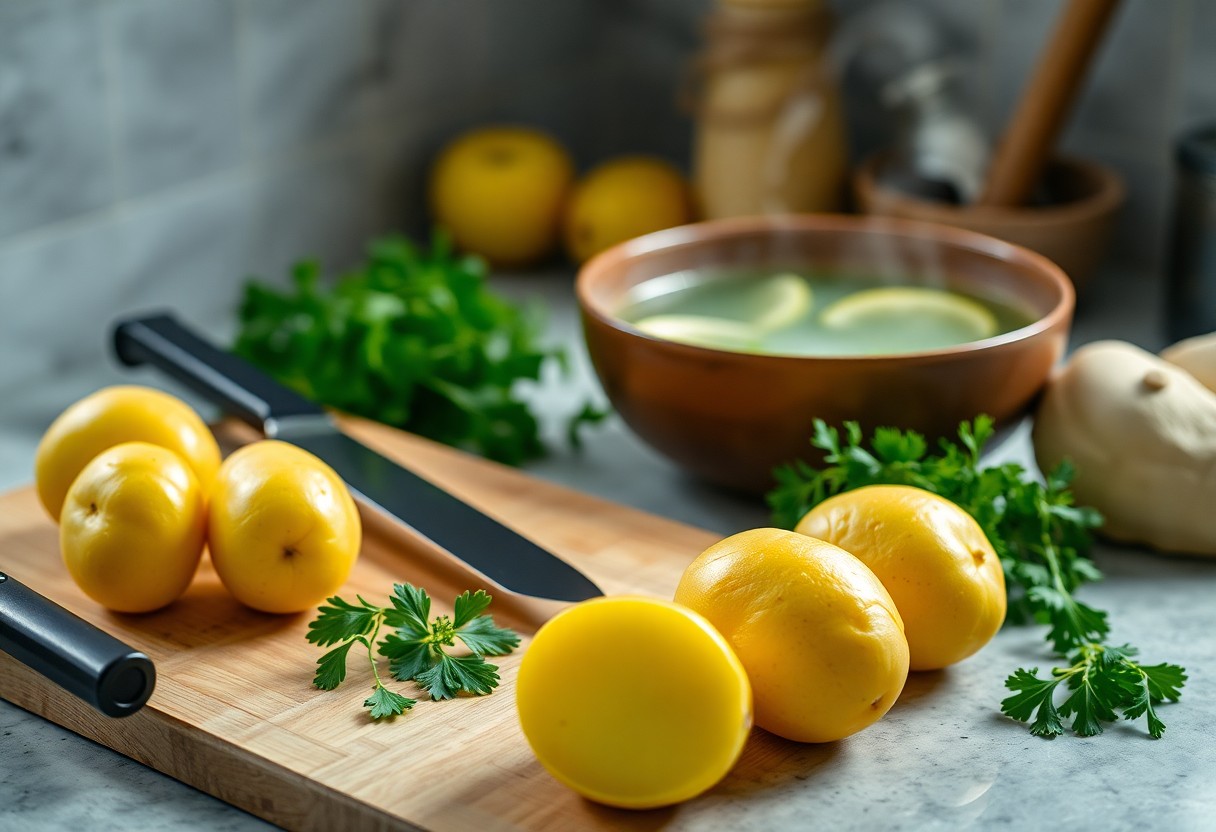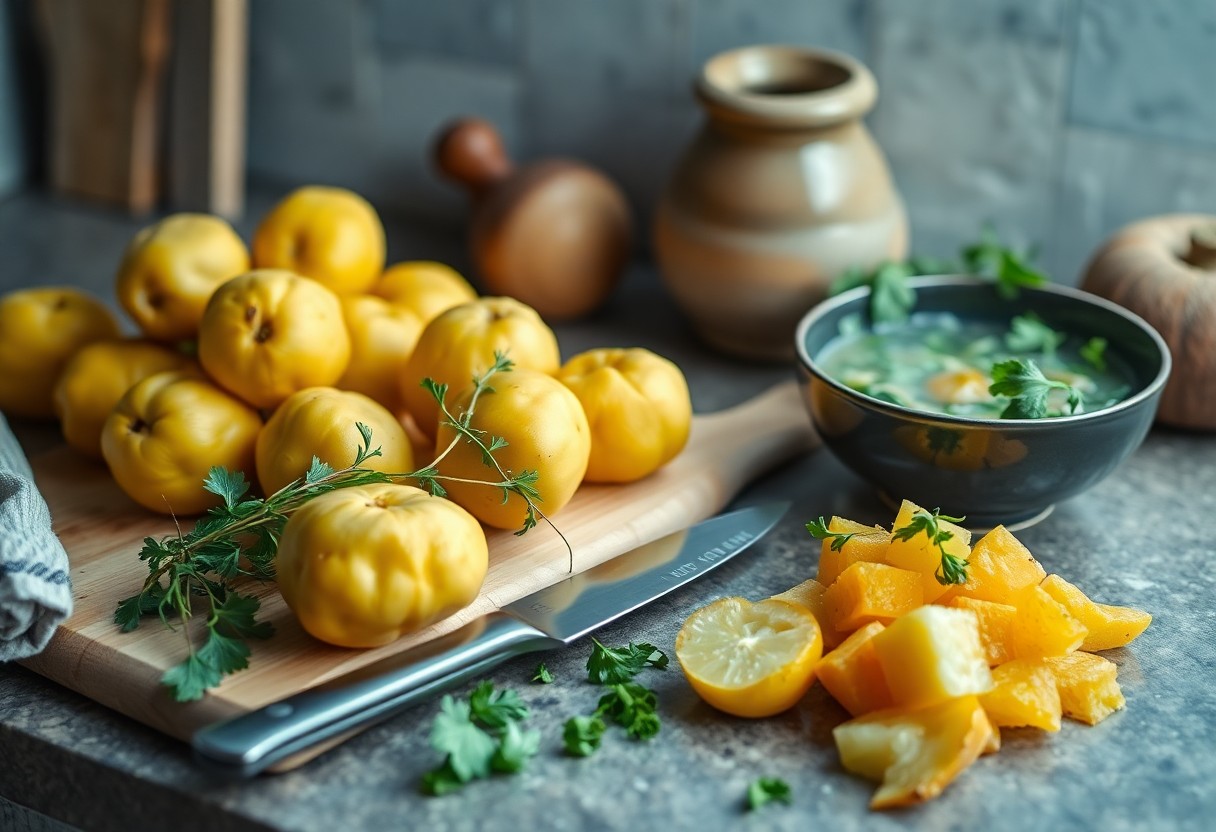It’s necessary to consider your choices when adding yellow potatoes to your soups. These versatile ingredients not only enhance the flavor of your dishes but also contribute to a comforting, creamy texture. Rich in nutrients like potassium and vitamin C, yellow potatoes can elevate your soup both in taste and health benefits. However, be cautious of cooking them too long, as overcooking can lead to a mushy consistency that may not be desirable. In this post, you’ll discover everything you need to know about using yellow potatoes in your soups.
Key Takeaways:
- Yellow potatoes, such as Yukon Gold, have a creamy texture and buttery flavor, making them an excellent choice for soups.
- They hold their shape well during cooking, adding a pleasing bite to the overall consistency of the soup.
- These potatoes are versatile and pair well with a variety of ingredients, enhancing the overall taste and nutrition of the soup.
Nutritional Benefits of Yellow Potatoes
Incorporating yellow potatoes into your diet not only enhances the flavor of your soups but also provides an array of nutritional benefits. They’re a great source of complex carbohydrates, making them a healthy energy source. Additionally, they are relatively low in calories and offer a range of important nutrients that contribute to overall well-being.
Essential Vitamins and Minerals
Yellow potatoes are packed with important vitamins and minerals, especially vitamin C, potassium, and vitamin B6. One medium-sized yellow potato contains about 27% of your daily recommended intake of vitamin C, which supports a healthy immune system. The high potassium content, around 620 mg per potato, helps regulate blood pressure and fluid balance.
Unique Flavor Profile and Texture
The distinct creamy texture and buttery flavor of yellow potatoes set them apart from other varieties. Their starch content allows them to break down beautifully when cooked, lending a velvety consistency to your soup while maintaining their shape. You’ll find that their slightly sweet undertones complement a wide range of ingredients, enhancing the overall taste of your dish.
This unique flavor profile makes yellow potatoes especially versatile. When simmered in broth, they not only absorb the savory flavors but also contribute a rich creaminess that creates a satisfying mouthfeel. Whether paired with herbs or mixed in with other vegetables, their natural sweetness balances saltiness and acidity, making them a standout ingredient in your soups.

The Culinary Versatility of Yellow Potatoes in Soup
Yellow potatoes are renowned for their ability to enhance a variety of soups, adding creaminess and depth of flavor. Their unique balance of waxy and starchy properties makes them ideal for mashing seamlessly into broth or retaining their shape in chunky soups. You can pair yellow potatoes with ingredients like herbs, vegetables, and proteins, allowing you to create everything from hearty stews to light bisques. The buttery flavor complements other components beautifully, making yellow potatoes a staple in any soup recipe.
Recommended Soup Recipes Featuring Yellow Potatoes
For a delightful experience, try your hand at a classic creamy potato leek soup, where yellow potatoes take center stage, creating a smooth and velvety base. Another option is a rustic yellow potato and vegetable soup brimming with seasonal produce, or a comforting chowder enriched with fresh seafood. Each recipe showcases the adaptability of yellow potatoes, making them a fantastic choice for all your soup-making adventures.
Preparing Yellow Potatoes for Optimal Soup Texture
Maximizing the texture of yellow potatoes in your soup involves selecting the right size and shape, as well as the cooking method. Make sure to cut potatoes into even, bite-sized pieces to ensure even cooking. Boiling, sautéing, or roasting before adding them to your soup base can intensify their flavor and achieve the perfect creaminess without becoming mushy.
Chopping your yellow potatoes into uniform pieces is vital; this ensures they cook evenly, providing that delightful, soft texture throughout your soup. Consider pre-cooking them with a bit of olive oil or butter to enhance their natural flavor. Additionally, incorporating them towards the end of the cooking process allows their unique qualities to shine without compromising their structural integrity. This method not only boosts the overall taste but also elevates the visual appeal of your dish, creating a comforting and aesthetically pleasing meal.
Comparing Yellow Potatoes to Other Varieties for Soups
| Potato Variety | Characteristics |
|---|---|
| Yellow Potatoes | Creamy texture, buttery flavor, holds up well in soups |
| Russet Potatoes | Starchy, fluffy texture, tends to break down in soups |
| Red Potatoes | Waxy, slightly sweet flavor, maintains shape, less creamy |
How Yellow Potatoes Stack Up Against Russet and Red Potatoes
Yellow potatoes are your go-to choice when making soups due to their creamy texture and rich flavor. In contrast, russet potatoes, while fluffy, often dissolve into mush, losing their texture. Red potatoes maintain their form and add a slightly sweet taste, but they lack the creaminess you seek for hearty soup consistency.
Flavor and Cooking Time Differences
The flavor profile of yellow potatoes gives them a distinct advantage in soups compared to russet and red varieties. Their buttery taste enhances the overall dish without overpowering other flavors, making your soup more delicious. Additionally, yellow potatoes tend to cook more quickly, often reducing your overall preparation time by about 10-15 minutes, since you won’t need to stew them as long to achieve that creamy consistency.
Yellow potatoes indeed shine in terms of flavor and cooking time. Their buttery texture contributes a delightful creaminess, allowing you to create rich, flavorful soups without needing to add excessive cream or butter. In contrast, russets may take longer to soften and can give a grainy texture if overcooked. Red potatoes will retain some firmness due to their waxy nature, which can be great for salads, but for soups, you want that smooth mouthfeel that yellow potatoes provide, keeping the cooking time efficient and enjoyable.
Common Misconceptions About Potatoes in Soup
Many home cooks harbor misconceptions about using potatoes in soups, especially regarding texture and flavor. Some believe that potatoes can overpower other ingredients, while others think they will make the soup too heavy. In reality, when you use yellow potatoes, their creamy texture enhances soups without overshadowing other flavors. Proper preparation and cooking techniques can ensure that potatoes contribute positively to your dish instead of becoming a dominating element.
Debunking Myths About Starch and Creaminess
Starch in yellow potatoes often gets a bad rap, with some asserting it leads to excessive creaminess or an undesirable texture. In fact, the starch present in yellow potatoes is what allows them to break down and create a velvety smooth base in soups. Instead of worrying about creaminess, you can embrace this quality to achieve that luscious mouthfeel that makes your soup more satisfying and delightful.
Addressing Dietary Concerns and Allergies
Concerns about dietary restrictions or allergies typically arise when incorporating potatoes into soups. Luckily, yellow potatoes are naturally gluten-free and suitable for most diets. They also provide necessary nutrients, including vitamin C and potassium, benefiting those seeking to enrich their meals. However, if you or your guests are sensitive to starches or carbohydrates, just monitor portion sizes to maintain balance without compromising flavor.
It’s worth noting that while yellow potatoes are generally safe for most, individual dietary needs can vary. For example, those with specific carbohydrate sensitivities might prefer to combine them with low-carb ingredients like cauliflower for a lighter rendition. Additionally, asking guests about allergies can help you avoid any mishaps. Cooking shouldn’t be stressful, and with a little knowledge, you can create soups that accommodate all dietary preferences without sacrificing taste.

Tips for Choosing and Storing Yellow Potatoes
Selecting the right yellow potatoes is vital for soup preparation. Look for potatoes that are firm, smooth, and free of blemishes. Avoid those with soft spots or green discoloration, as these can indicate spoilage. Consider the size based on your cooking needs; smaller ones cook faster, while larger potatoes are better for chunkier soups. Lastly, inspect the skin for any signs of sprouting.
- Choose firm, smooth potatoes
- Avoid soft spots and greening
- Select based on cooking needs
Any potatoes that meet these criteria will enhance your soup experience.
Selecting the Best Quality Potatoes
The best yellow potatoes should feel heavy for their size and have a vibrant golden hue. Inspect the skin closely; it should be intact and unbroken, indicating freshness. Varieties like Yukon Gold and Butterball are popular options, known for their creamy texture and delightful flavor that elevates any soup. Always opt for locally sourced when possible, as they tend to be fresher and tastier.
Proper Storage Techniques for Freshness
Storing yellow potatoes correctly will keep them fresh for weeks. They thrive in a cool, dark, and well-ventilated space. A paper bag or cardboard box works beautifully, but avoid storing them in the fridge, as cold temperatures can alter their flavor and texture. Keep them away from onions, as the gases emitted can expedite spoilage.
Proper storage techniques include monitoring your potato stash regularly for any signs of sprouting or softness, which can lead to spoilage. Maintaining a consistent environment—in a pantry or cellar—helps to regulate temperature and moisture levels. You can extend the shelf life by placing them in mesh bags to allow airflow while ensuring they remain out of direct sunlight.
Summing up
The answer to whether yellow potatoes are good for soup lies in their unique flavor and creamy texture, making them an excellent choice for various recipes. You can enjoy their natural butteriness, which enhances the overall taste of your soup. When using yellow potatoes, be sure to cut them into even pieces for consistent cooking. So, if you’re looking to elevate your soup game, consider incorporating yellow potatoes for a delightful and satisfying result.
FAQ
Q: Are yellow potatoes the best choice for making soup?
A: Yellow potatoes are a great option for soup due to their creamy texture and ability to hold their shape well during cooking. Varieties like Yukon Gold are particularly popular because they add a rich, buttery flavor to soups, enhancing the overall taste. However, the best choice also depends on personal preference and the specific recipe you are using.
Q: How do yellow potatoes compare to other types of potatoes in soup recipes?
A: Yellow potatoes tend to have a slightly waxy texture compared to starchy potatoes like Russets. This means they retain their shape better and contribute a smooth creaminess to the broth. While starchy potatoes can break down and thicken the soup, yellow potatoes strike a balance, making them versatile for both chunky and pureed soups.
Q: Do yellow potatoes require any special preparation before adding them to soup?
A: When using yellow potatoes for soup, it’s generally a good idea to wash and peel them, although leaving the skin on can add nutrients and texture. Cut them into uniform pieces to ensure even cooking. Soaking them briefly in cold water can help remove excess starch, resulting in a lighter soup consistency if desired.
Q: Can yellow potatoes be used in both creamy and broth-based soups?
A: Yes, yellow potatoes are versatile enough for both creamy and broth-based soups. They blend well into cream soups, adding richness, while also holding up nicely in lighter broth-based soups. Their flavor complements a variety of ingredients, making them an excellent choice for diverse recipes.
Q: Are there any dietary considerations when using yellow potatoes in soup?
A: Yellow potatoes are naturally gluten-free and can be a healthy addition to your diet, providing necessary nutrients like potassium and vitamin C. However, if you are watching carbohydrate intake, it’s important to consider portion sizes, as potatoes do contain carbohydrates. Additionally, adding ingredients such as heavy cream can increase the caloric content, so be mindful of what else you are including in your soup recipe.
